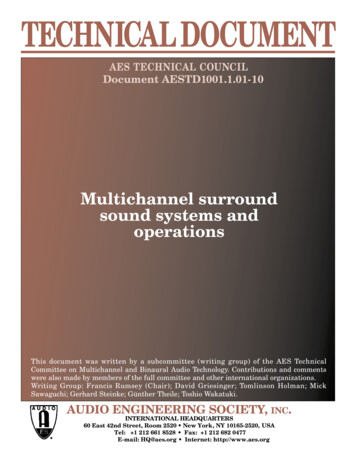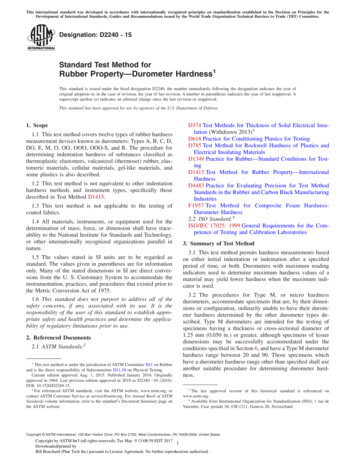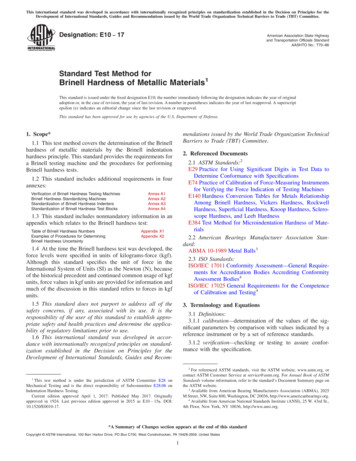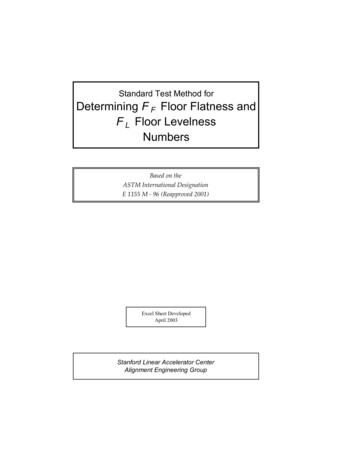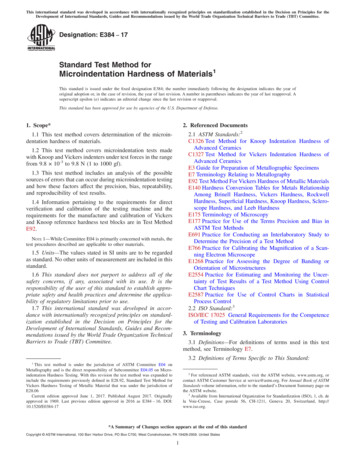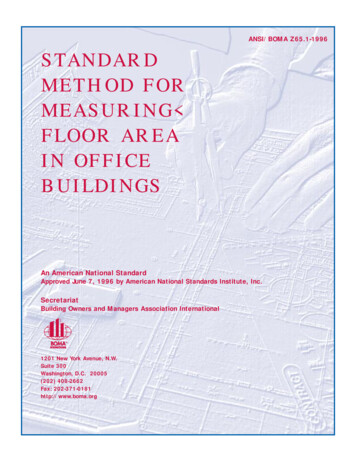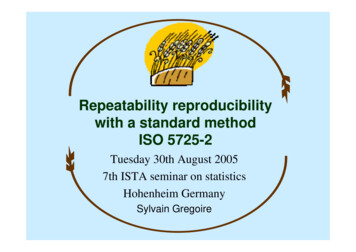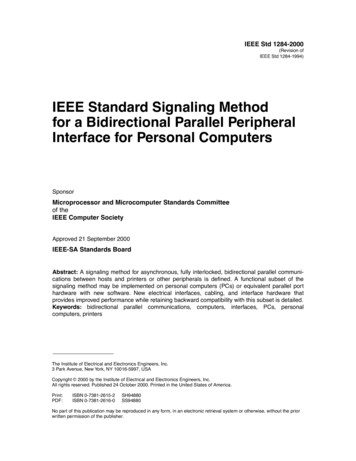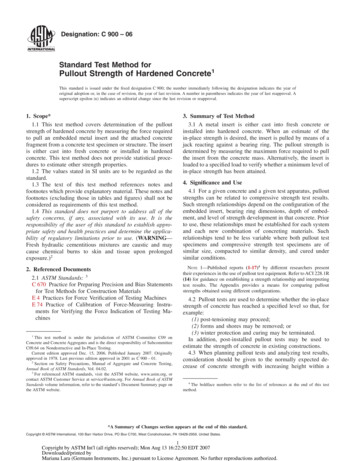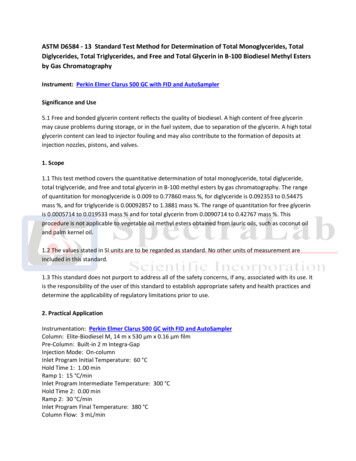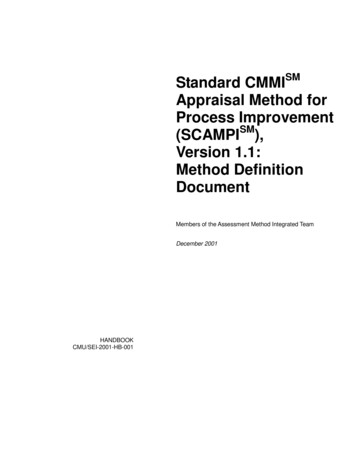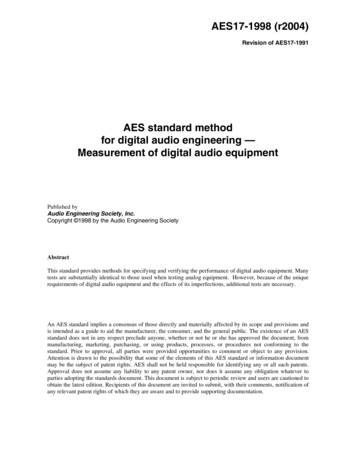
Transcription
AES17-1998 (r2004)Revision of AES17-1991AES standard methodfor digital audio engineering —Measurement of digital audio equipmentPublished byAudio Engineering Society, Inc.Copyright 1998 by the Audio Engineering SocietyAbstractThis standard provides methods for specifying and verifying the performance of digital audio equipment. Manytests are substantially identical to those used when testing analog equipment. However, because of the uniquerequirements of digital audio equipment and the effects of its imperfections, additional tests are necessary.An AES standard implies a consensus of those directly and materially affected by its scope and provisions andis intended as a guide to aid the manufacturer, the consumer, and the general public. The existence of an AESstandard does not in any respect preclude anyone, whether or not he or she has approved the document, frommanufacturing, marketing, purchasing, or using products, processes, or procedures not conforming to thestandard. Prior to approval, all parties were provided opportunities to comment or object to any provision.Attention is drawn to the possibility that some of the elements of this AES standard or information documentmay be the subject of patent rights. AES shall not be held responsible for identifying any or all such patents.Approval does not assume any liability to any patent owner, nor does it assume any obligation whatever toparties adopting the standards document. This document is subject to periodic review and users are cautioned toobtain the latest edition. Recipients of this document are invited to submit, with their comments, notification ofany relevant patent rights of which they are aware and to provide supporting documentation.
–2–AES17-1998 (r2004)ContentsForeword. 31 Scope . 42 Normative references. 43 Definitions and abbreviations . 44 Procedures. 65 Input characteristics . 106 Output characteristics . 127 Linear response. 138 Amplitude non-linearity. 169 Signal-to-noise measurement. 1710 Cross-talk and separation. 18Annex A (informative) Informative references . 202004-03-03 printing
–3–AES17-1998 (r2004)Foreword[This foreword is not a part of AES standard method for digital audio engineering — Measurement of digitalaudio equipment, AES17-1998]This document has been prepared by the SC-02-01 Working Group on Digital Audio Measurement Techniquesof the SC-02 Subcommittee on Digital Audio of the Audio Engineering Society Standards Committee. It is arevision of AES17-1991. With the permission of AESSC, it also had been independently released by ANSIAccredited Standards Committee S4 as ANSI S4.51-1991.Discussions on the revision project, AES17-R, began in the autumn of 1995. Proposals for revision have beendiscussed at five subsequent open working group meetings and over the working group reflector,SC 02 01@aessc.aes.org. The call for comment on its draft was published 1997-10-09 onhttp://www.aes.org/standards and was distributed with the Journal of the Audio Engineering Society, vol. 45,no. 11. The comment record is posted at http://www.aes.org/standards/comments.The following individuals contributed to the preparation of the 1991 edition of this document: Robert Adams,Richard Cabot, Louis Fielder, David Haynes, and Tomlinson Holman. The revision was prepared by R. Cabotbased on the working group discussions.Richard Cabot, ChairmanWorking Group SC-02-01 on Digital Audio Measurement Techniques1998-032004-03-03 printing
–4–AES17-1998 (r2004)AES standard methodfor digital audio engineering —Measurement of digital audio equipment1 ScopeThis standard provides methods for specifying and verifying the performance of digital audio equipment. Itdescribes the testing of medium- and high-performance digital audio equipment. The characteristics of voicegrade digital audio devices are sufficiently different from those of high-performance equipment that some ofthe test levels and frequencies specified in this document may need to be revised for such applications. Lowbit-rate coders are an example of devices that will require additional test techniques to be developed. Thenature of such coders dictates that the test methods be based on psychoacoustic models which can predictaudible performance. However, the techniques described here should still be informative for such systems.Another caveat concerns digital devices which purposely modify the time-domain characteristics of the audiosignal, such as pitch shifters and reverberators. Many of the tests in this standard were prepared assuming thatthe frequency spectrum of the output signal is substantially the same as that of the input signal. Also, largeamplitude interfering signals (as would be encountered with reverberators) have not been considered.Many tests are substantially identical to those used when testing analog equipment. However, because of theunique requirements of digital audio equipment and the effects of its imperfections, additional tests arenecessary. Some tests have been omitted while the appropriate modifications required for use in testing digitalaudio systems are being developed.2 Normative referencesThe following standards contain provisions that, through reference in this text, constitute provisions of thisdocument. At the time of publication, the editions indicated were valid. All standards are subject to revision,and parties to agreements based on this document are encouraged to investigate the possibility of applying themost recent editions of the indicated standards.AES3-1992, AES recommended practice for digital audio engineering — Serial transmission format for twochannel linearly represented digital audio data. New York, NY, USA: Audio Engineering Society, 1992.ITU-R BS.468-4, Measurement of audio-frequency noise voltage in sound broadcasting. Geneva, Switzerland:International Telecommunication Union, 1986.IEC 61260 (1995-08), Electroacoustics — Octave-band and fractional-octave-band filters. Geneva,Switzerland: International Electrotechnical Commission, 1995.IEC 60268-3 (1988-09), Sound system equipment Part 3: Amplifiers. Geneva, Switzerland: InternationalElectrotechnical Commission, 1988.3 Definitions and abbreviationsFor the purposes of this standard, the following definitions apply.3.1folding frequencyone-half the sampling frequency of the digital systemNOTE Signals applied to the input which are greater than this frequency are subject to aliasing. Insystems that sample at a frequency higher than that ultimately used, stored, or produced by the system,2004-03-03 printing
–5–AES17-1998 (r2004)the sampling frequency to be considered is the lowest sampling frequency that occurs in the signalpath.3.2aliasing componentscomponents that fold down from the folding frequency due to input signals above the folding frequency3.3full-scale amplitudeamplitude of a 997-Hz sine wave whose positive peak value reaches the positive digital full scale, leaving thenegative maximum code unused.NOTE In 2's-complement representation, the negative peak is 1 LSB away from the negativemaximum code.3.3.1decibels, full scaledB FSamplitude expressed as a level in decibels relative to full-scale amplitude (20 times the common logarithm ofthe amplitude over the full-scale amplitude)NOTE The rules of the International System of Units (SI) require that a space appear after thestandard symbol dB.3.3.2percent, full scale% FSamplitude expressed as a percentage of full-scale amplitude (100 times the amplitude over the full-scaleamplitude)3.4full-scale signal levelFSsignal amplitude relative to the full-scale amplitude expressed in decibels, full scale or percent, full scaleNOTE Because the definition of full scale is based on a sine wave, it will be possible with squarewave test signals to read as much as 3,01 dB FS. Square-wave signals at this level are notrecommended because tilt or overshoot introduced by any filtering operations will cause clipping ofthe signal.3.5upper band-edge frequencyhighest signal frequency to be measuredNOTE See 4.2.23.6digital zerosignal that has all zeros for all samplesNOTE Digital zero is the only test signal in this standard that is not dithered.3.7jitter susceptibilityeffect on equipment-under-test (EUT) performance of jitter present on the signal or reference inputs.2004-03-03 printing
–6–AES17-1998 (r2004)4 Procedures4.1 Measurement conditions4.1.1 All tests in this standard shall be performed at an ambient temperature of 23 5 C unless otherwisespecified. When specifications are listed for a device with a temperature range of operation, these specificationsare assumed to be valid over the entire range and shall be so verified.4.1.2 Power-line (mains) voltage shall be set within 2 % of the nominal value listed on the panel of the devicebeing tested. If a range of values is given, the specifications are assumed to be valid over the entire range andmay be so verified.4.1.3 Power-line (mains) frequency shall be set within 1 % of the nominal value listed on the panel of thedevice being tested. If a range of values is given, the specifications are assumed to be valid over the entirerange and shall be so verified.4.1.4 For dc-powered devices the dc supply voltage shall have a peak-to-peak ripple content of less than 0,5 %of the nominal supply voltage.4.2 Instrumentation4.2.1 Standard low-pass filter4.2.1.1 For the upper band-edge frequency of 20 kHz, the standard low-pass filter shall have the followingcharacteristics:a) passband response deviation: 0,1 dB, 10 Hz f 20 kHz;b) stop-band attenuation: 60 dB, f 24 kHz.4.2.1.2 For an upper band-edge frequency less than 20 kHz, the standard low-pass filter shall have thefollowing characteristics:a) pass-band response deviation: 0,1 dB, 10 Hz f upper band-edge frequency;b) stop-band attenuation: 60 dB, f (sampling frequency – upper band-edge frequency).4.2.2 Standard high-pass filterThe standard high-pass filter shall have a passband ripple of less than 1 dB peak to peak and a stop-bandattenuation of greater than 40 dB. The lower edge of the filter transition band shall equal the upper band-edgefrequency defined in 3.5. The upper edge of the transition band shall be no greater than 1,3 times the upperband-edge frequency defined in 3.5.4.2.2.1 For an upper band-edge frequency less than 20 kHz, the standard high-pass filter shall have thefollowing characteristics:a) passband response deviation: 0,5 dB, 1,3 times upper band-edge frequency f 200 kHz;b) stop-band attenuation: 40 dB, 10 Hz f upper band-edge frequency.4.2.2.2 If the standard upper band-edge frequency of 20 kHz is used, the standard high-pass filter shall have thefollowing characteristics:a) passband response deviation: 0,5 dB, 26 kHz f 200 kHz;b) stop-band attenuation: 40 dB, 10 Hz f 20 kHz.NOTE It is possible to implement this characteristic with a 5-pole elliptic or 7-pole Chebyshev filter.2004-03-03 printing
–7–AES17-1998 (r2004)4.2.3 Standard weighting filterThe standard weighting filter for all weighted noise measurements should conform to ITU-R BS 468-4 exceptfor overall gain. The filter unity-gain frequency should be taken to be 2 kHz, equivalent to inserting anattenuation of 5,629 dB at all frequencies. Relative amplitude measurements, such as signal-to-noise ratio,performed using this recommended standard weighting filter, shall be abbreviated dB CCIR-R.M.S. Absoluteamplitude measurements performed using this recommended filter shall be denoted by the appropriate quantityabbreviation followed by CCIR-R.M.S.; for example, dB FS shall be dB FS CCIR-R.M.S. If a standardweighting filter differing from this recommendation is used for a measurement according to this standard, thefilter network — and gain if appropriate — shall be specified.4.2.4 Standard notch filterThe standard notch filter shall be a separate notch filter when used instead of a THD N distortion analyzer. Itshall have an electrical Q of at least 1 and not more than 5. This value shall be verified by measuring the – 3dB frequencies and computing the ratio of the center frequency to the difference between the – 3-dBfrequencies. Multistage notch filters shall be acceptable if their combined Q measures within these limits usingthis definition.4.2.5 Dither signalThe dither signal shall be a random or pseudorandom sequence having a triangular probabi
IEC 60268-3 (1988-09), Sound system equipment Part 3: Amplifiers. Geneva, Switzerland: International Electrotechnical Commission, 1988. 3 Definitions and abbreviations For the purposes of this standard, the following definitions apply. 3.1 folding frequency one-half the sampling frequency of the digital system
